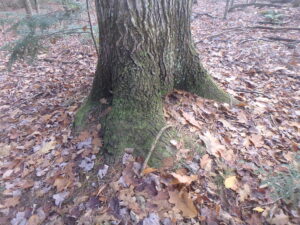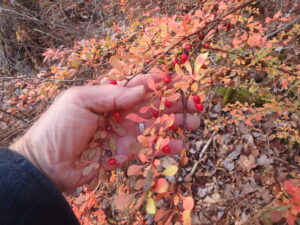Late Fall Chores in the Garden
Posted on Tuesday, October 31, 2023 · Leave a Comment
For many of us, November is a drab and dreary month: days are short, gray skies the norm. Flowers are largely gone, the soil is soggy and a drizzle or a downpour is common. Soon snow will not be unusual- we’ve already seen a wintry mix. But there are things you can do when the sun comes out – or with rain gear on.

Trunk flare is easy to see on big trees but harder on new plantings
If you planted trees in the past few years, you should look at them carefully. Most planting tags on purchased trees tell you to plant them at the depth they are in the pot. Unfortunately, many trees are grown on huge farms and slapped into pots without regard to the “trunk flare” – that part of the tree that should be above ground.
Look at a mature tree planted by mother nature – or a squirrel. You will see that the base of the tree widens out, and often roots are seen snaking across the soil near the tree for a while before diving down to seek nutrients and moisture. When planting a tree it is essential that the trunk flare be above ground. If not, soil fungi will rot the bark and eventually kill the cambium layer below it. This will kill the tree in six to ten years. Even if the bark looks flaky and damaged, it probably will recover if you take action now.
If the tree you planted comes straight out of the ground like a telephone pole, or if there is mulch piled up against the tree, you must remove the material that will cause problems.
Mulch is easy to fix – take your hand and pull it back, creating a doughnut hole for the trunk, at least 4-inches all around. Mulch has its place: it will keep down weeds and help prevent the soil from drying out in times of drought. But more than 4 inches of mulch can also prevent light rains from reaching the roots. Don’t overdo it. No mulch volcanoes. I’ve been seen removing mulch from trees in public spaces!
If there is soil over the trunk flare, use a hand tool to loosen the soil and pull it back, too. You may find little roots there, but cut them off. Re-grade the area for a foot or more around the tree in ll directions. For a larger tree that was sold in a burlap wrapping, it is not uncommon to find 3 to 6 inches of soil over the trunk flare. The burlap wrapping – now often made of plastic materials – should have been removed at planting time. If not, your tree is doomed. Plastic wrapping will never degrade, so need to dig up the tree and remove it now. Burlap will degrade in time, but often not for years.
What else is there to do in the garden now? This is a good time to move shrubs or small trees that are not doing well where they are. Roots do most of their growth between the time leaves drop and the ground freezes, ,which makes this a good time for moving them. Cool temperatures and rainy days help plants you move now, too. sd

Mulch around a tree will hold in water and help keep weeds from stealing water.
I was visiting long-time friends in Ohio recently, and they had 3 Fothergilla shrubs that had been in the ground 5 years and done almost nothing. I took a garden fork, thrust it into the soil nearby and tipped it back. Out popped the root ball – as if it had been planted the day before. I picked it up and took a look. Clearly the shrub had been in a one-gallon pot for a long time before they planted it. The roots had grown around and around the pot, keeping them from extending out into neighboring soil for moisture and minerals.
After soaking the root ball in a pail of water, I used my fingers, a small folding saw and a CobraHead weeder to tease the roots apart. I broke or cut some, but it didn’t matter. The shrubs were doomed unless I could get the roots pointed out and away from the tangled mess they’d been in. I replanted them in places with more sunshine and less competition from big perennials in beds where they should grow and be happy. It may take a year or two before they really start to thrive.
It’s tough to know just where to plant a tree or shrub for optimal growth. I like to observe the same species in another garden or ask a friend if they’ve had luck with the same species. The internet can help if you consult a university or arboretum website. I like books, too, especially any written by Michael Dirr. He seems to know more than anyone else. So do your homework, and think about moving any unhappy woody plants.
By the way, it’s not too late to plant spring bulbs, garlic or bulbs for forcing in pots. I particularly like forcing spring bulbs (daffodils, tulips, crocus and more) by potting them up now and keeping them in a cold place where they won’t freeze. Then in February and March I bring them into the warmth of the house, and they bloom early. I pot up enough to give some away to ailing or aged friends.

Barberry is easily identified by its red berries now
This is a good time to dig out invasive shrubs like burning bush or barberry that have been planted by birds. Their distinctive leaf color will help you find them now in your woods.
On the next to last day of October this year I plugged in my blue “fairy lights” in my Merrill magnolia and a nice pear tree. It was a gloomy, wet day, and the blue lights looked great against the yellow leaves. Some people call these Christmas or holiday lights, but I consider them just a cheerful boost to my spirits when gardening is nearly done and weather keeps me from doing my final chores.
Henry is UNH Master
Gardener, a regular speaker at
garden clubs and libraries, and the author of 4
gardening books. Reach him by e-mail at henry.homeyer@comcast.net.





